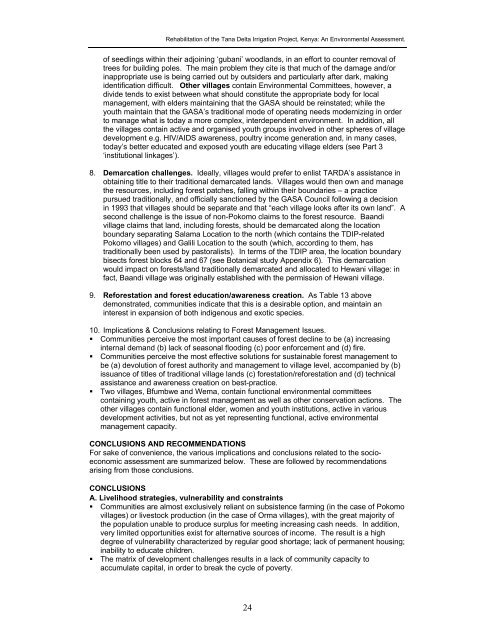Tana Delta Irrigation Project, Kenya: An Environmental Assessment
Tana Delta Irrigation Project, Kenya: An Environmental Assessment
Tana Delta Irrigation Project, Kenya: An Environmental Assessment
Create successful ePaper yourself
Turn your PDF publications into a flip-book with our unique Google optimized e-Paper software.
Rehabilitation of the <strong>Tana</strong> <strong>Delta</strong> <strong>Irrigation</strong> <strong>Project</strong>, <strong>Kenya</strong>: <strong>An</strong> <strong>Environmental</strong> <strong>Assessment</strong>.<br />
of seedlings within their adjoining ‘gubani’ woodlands, in an effort to counter removal of<br />
trees for building poles. The main problem they cite is that much of the damage and/or<br />
inappropriate use is being carried out by outsiders and particularly after dark, making<br />
identification difficult. Other villages contain <strong>Environmental</strong> Committees, however, a<br />
divide tends to exist between what should constitute the appropriate body for local<br />
management, with elders maintaining that the GASA should be reinstated; while the<br />
youth maintain that the GASA’s traditional mode of operating needs modernizing in order<br />
to manage what is today a more complex, interdependent environment. In addition, all<br />
the villages contain active and organised youth groups involved in other spheres of village<br />
development e.g. HIV/AIDS awareness, poultry income generation and, in many cases,<br />
today’s better educated and exposed youth are educating village elders (see Part 3<br />
‘institutional linkages’).<br />
8. Demarcation challenges. Ideally, villages would prefer to enlist TARDA’s assistance in<br />
obtaining title to their traditional demarcated lands. Villages would then own and manage<br />
the resources, including forest patches, falling within their boundaries – a practice<br />
pursued traditionally, and officially sanctioned by the GASA Council following a decision<br />
in 1993 that villages should be separate and that “each village looks after its own land”. A<br />
second challenge is the issue of non-Pokomo claims to the forest resource. Baandi<br />
village claims that land, including forests, should be demarcated along the location<br />
boundary separating Salama Location to the north (which contains the TDIP-related<br />
Pokomo villages) and Galili Location to the south (which, according to them, has<br />
traditionally been used by pastoralists). In terms of the TDIP area, the location boundary<br />
bisects forest blocks 64 and 67 (see Botanical study Appendix 6). This demarcation<br />
would impact on forests/land traditionally demarcated and allocated to Hewani village: in<br />
fact, Baandi village was originally established with the permission of Hewani village.<br />
9. Reforestation and forest education/awareness creation. As Table 13 above<br />
demonstrated, communities indicate that this is a desirable option, and maintain an<br />
interest in expansion of both indigenous and exotic species.<br />
10. Implications & Conclusions relating to Forest Management Issues.<br />
• Communities perceive the most important causes of forest decline to be (a) increasing<br />
internal demand (b) lack of seasonal flooding (c) poor enforcement and (d) fire.<br />
• Communities perceive the most effective solutions for sustainable forest management to<br />
be (a) devolution of forest authority and management to village level, accompanied by (b)<br />
issuance of titles of traditional village lands (c) forestation/reforestation and (d) technical<br />
assistance and awareness creation on best-practice.<br />
• Two villages, Bfumbwe and Wema, contain functional environmental committees<br />
containing youth, active in forest management as well as other conservation actions. The<br />
other villages contain functional elder, women and youth institutions, active in various<br />
development activities, but not as yet representing functional, active environmental<br />
management capacity.<br />
CONCLUSIONS AND RECOMMENDATIONS<br />
For sake of convenience, the various implications and conclusions related to the socioeconomic<br />
assessment are summarized below. These are followed by recommendations<br />
arising from those conclusions.<br />
CONCLUSIONS<br />
A. Livelihood strategies, vulnerability and constraints<br />
• Communities are almost exclusively reliant on subsistence farming (in the case of Pokomo<br />
villages) or livestock production (in the case of Orma villages), with the great majority of<br />
the population unable to produce surplus for meeting increasing cash needs. In addition,<br />
very limited opportunities exist for alternative sources of income. The result is a high<br />
degree of vulnerability characterized by regular good shortage; lack of permanent housing;<br />
inability to educate children.<br />
• The matrix of development challenges results in a lack of community capacity to<br />
accumulate capital, in order to break the cycle of poverty.<br />
24

















